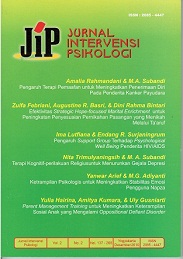Main Article Content
Abstract
Strategic hope-focused marital enrichment is on brief marital enrichment program with an eclectic approach that focused on increasing love, faith and the importance of working together as a couple to motivate couple in increasing their relationship's quality (Jakubowski, Milne, Brunner, and Miller,2004). The program improved marital relationship, communication, maritalsatisfaction(Worthington Jr., Hight, Ripley, etal, 1997) and overall quality of life (Buchard, Yarhouse, Killian, Worthington Jr., 2003). Rumondor (2010) had adopted the program on newlywed-couples that experienced dating before. This research is to test the effetivity of the program to three ta'aruf-married couples in their beginning phase of marriage. The participants attended four sessions for about a month. The quality of marital adjustment is measured by Dyadic Adjustment Scale (DAS), developed by Spanier (1976). The average total score of DAS in three couples showed an increasing on marital adjustment quality at the end of the program. The program increases dyadic consensus, dyadic satisfaction and affectionai expression meanwhile does not show any difference on dyadic cohesion.
Keywords: Marital enrichment, marital adjustment, beginning phase of marriage, ta'arufArticle Details
Authors who publish with this journal agree to the following terms:
- Authors retain copyright and grant the journal right of first publication with the work simultaneously licensed under a Creative Commons Attribution-ShareAlike 4.0 International License that allows others to share the work with an acknowledgment of the work's authorship and initial publication in this journal.
- Authors are able to enter into separate, additional contractual arrangements for the non-exclusive distribution of the journal's published version of the work (e.g., post it to an institutional repository or publish it in a book), with an acknowledgment of its initial publication in this journal.
- Authors are permitted and encouraged to post their work online (e.g., in institutional repositories or on their website) prior to and during the submission process, as it can lead to productive exchanges, as well as earlier and greater citation of published work (See The Effect of Open Access).




